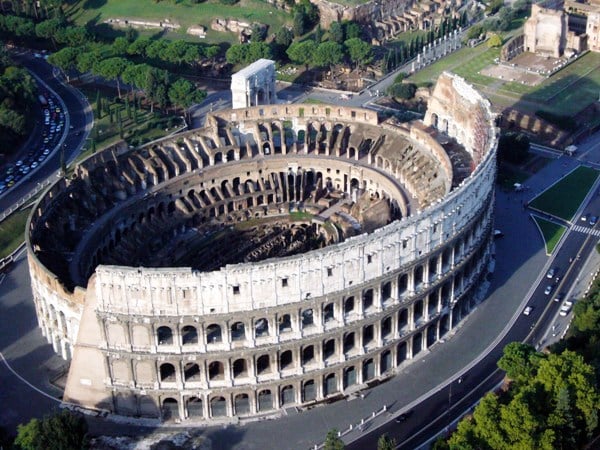The Piazza Campo de’ Fiori in Rome Italy, has been a meeting place for centuries. In the center of the plaza is a statue of Giordano Bruno, a monk burned for heresy in the year 1600. The not as well known Croatian born scientist Marco Antonio Dominis managed to die a natural death in September, 1624 but a few months later his heresy was declared manifest, and by order of the Inquisition his body was taken from the coffin, dragged through the streets of Rome, and publicly burnt in the Campo de’ Fiori, along with his works, a few days before Christmas of that same year.

Some say that Dominis was the first to develop the theory of the rainbow, and he was an expert on tides, but that wasn’t what got him in trouble. For over one hundred fifty years the piazza has hosted a fish and produce market. This is an in spot at night.
In 1536 Michelangelo started designing the Piazza del Campidoglio plaza on top of the Capitoline hill in central Rome. Instead of facing the Roman Forum, the plaza faced Saint Peter’s Basilica and the design was to mark a new trend in city planning. The centerpieces were the Capitoline Museums. However, these magnificent edifices were not ready on time for the visit of Charles V, the Holy Roman Emperor. In fact, they weren’t completed until the Seventeenth Century. In fact the paving design itself was completed only in 1940, under the orders of Benito Mussolini.
The three main buildings are the Twelfth Century Palazzo Senatorio modified by Michelangelo, the Sixteenth Century Palazzo dei Conservatori, also redesigned by Michelangelo, and the Seventeenth Century Palazzo Nuovo whose exterior is identical to the Palazzo dei Conservatori. In addition the Palazzo Caffarelli Clementino hosts short-term exhibitions, until World War I it hosted the German Embassy.
What about the contents? The art collection predates the museums; a Pope donated ancient bronzes to the people of Rome and placed them on the Capitoline Hill. The collections include some of the most celebrated sculptures of the ancient world, including the original of the equestrian statue of Marcus Aurelius that once stood in the piazza. Many beautiful sculptures are copies of Greek’s masterpieces. There is a bronze statue of a she-wolf suckling Romulus and Remus, the twins who founded Rome. The Galleria Congiunzione links the three palaces and contains the remains of Second Century Roman dwellings.
There’s lots more.
The Colosseo (Colosseum) located in south-central Rome has been a symbol of The Eternal City since its creation in 80 AD. This is the largest Roman Amphitheater, built to hold 50 thousand spectators in great comfort as they watched the slaughter of gladiators and wild beasts. It is said that 5 animals died the day (and night) that this monument to human cruelty opened. But you shouldn’t go to Rome without visiting.
After the gladiator combats ended early in the Fifth Century the site served as a quarry for building materials found in Renaissance palaces and churches including St. Peter’s Basilica. Let your imagination run wild and decide whether you want to be photographed with a costumed gladiator who will demand money for the privilege. You won’t have to pay anything for the kitty cats that have replaced the lions.
To the west of the Colosseum is the Arco di Costantino (Arch of Constantine) at about 70 feet high, 85 feet long, and 23 feet wide (about 21 by 26 by 7 meters), the largest and incidentally best-preserved of the Roman triumphal arches. This one built in 315 AD marks the victory of Emperor Constantine over his co-emperor Maxentius. Just before the battle Constantine has a vision of a cross in the heavens and subsequently legalized Christianity in his empire.
Northeast of the Colosseum lies the Domus Aurea (GoldenHouse) that once belonged to that great fiddler, Nero.
This palace, still viewable in part, occupied more than a third of the city, a monument to greed. It actually disappeared for centuries. The great painter Raphael worked on its restoration. Don’t expect to see everything as it was, but this is one great, or should we say disgusting, monument to unbridled luxury.
